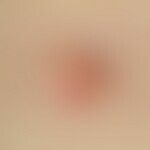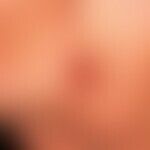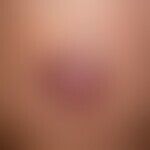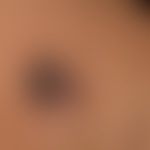Synonym(s)
Nodulus; Nodus; Tumor; Tumour
DefinitionThis section has been translated automatically.
Circumscribed, fixed, hemispherical or even asymmetrically configured substance propagation (nodes > 1.0 cm). A node always exceeds the size of a papule.
A nodule can be located in the dermis or deep in the subcutis. A nodule is caused by neoplastic (benign or malignant) or inflammatory cell proliferation.
Histological substrates of nodule formation are most frequently inflammation, deposits of foreign substances, neoplasia or tissue hyperplasia.
ClassificationThis section has been translated automatically.
A clinical classification of nodular skin diseases leading to differential diagnostic evaluations can only be made according to clinical-morphological criteria. In this classification, the colour of a nodule and the position of the nodule in the skin and subcutis are taken into account. The position of a node in the skin and subcutis is determined by simple palpation and must be assessed before applying a further diagnostic classification. Other important diagnostic criteria are subjective sensations such as "painfulness".
General informationThis section has been translated automatically.
- Nodules are firm skin habits or skin indurations which are larger than a papule (> 1.0 cm). A nodule may clearly protrude above the skin level, but it may also lie below it, in the depth of the skin or in the subcutaneous fatty tissue and involve the skin only secondarily. If the node lies in the subcutaneous fatty tissue, the otherwise intact skin is only stretched over the node; it remains movable above the actual process.
- The term "tumour" is used synonymously with nodules, although it is also increasingly being equated with a "malignant" skin tumour in common parlance.
- As with all morphological indices, further subjective and objective phenomena are important for the efflorescence characteristics, according to the localization. Juxtaarticular nodules will make one think of rheumatic or rheumatoid processes. Nodules on the capillitium are mostly new formations, starting from the hair follicles. In the case of nodular formations in the facial region, malignant tumours ( basal cell carcinoma, squamous cell carcinoma) are the main focus of diagnostic considerations.
- For the differential diagnostic evaluation of a nodule, the characteristics of the overlying skin, such as its colour, signs of atrophy or melting, are also evaluated (from this, indications of the underlying process can be drawn). A verrucous surface is generally caused by a proliferation of the surface epithelium.
- In addition to the colour "red" (e.g. caused by hyperemia or bleeding), other colours such as yellow, brown or black are suitable for providing important information on the proliferating or acting cell systems. Brown and black describe melanocytic or hemosiderotic nodules. Yellow, for example, represents fat-storing nodes. The colour "red" is caused by an increase in erythrocyte count / tissue unit.
- The red colour of a knot combined with painfulness suggests its inflammatory nature. Examples are the inflammatory, cystic nodules in acne vulgaris. The diagnosis of acne vulgaris cannot be made from the isolated acne node. Only the typical environment with pustules and comedones and the clinical symptoms allow the diagnosis of "inflammatory lump formation" in the context of acne vulgaris.
- The homogeneously reddened, smooth-surfaced, firm, painless nodules of the cutaneous B-cell lymphoma cannot be diagnosed purely morphologically as malignant lymphatic neoplasia. Due to its colour, it certainly allows consideration of an inflammatory process. However, the medical history (often long duration > 6 months) and painlessness usually speak against this. In the presence of such a constellation of symptoms, further detailed diagnostic clarification with laboratory and histology is required.
- The palpation findings are of great importance for the nodule characteristics. These include consistency, shifting in relation to the environment, as well as the symptom painfulness.
- In the case of a severe lump, the differential diagnosis will primarily be a benign or malignant neoplasia.
- Keloids as benign connective tissue tumours or the dermatofibrosarcoma protuberans as malignant connective tissue tumour are very crude.
- Cystic nodules such as atheromas or synovial cysts can be felt elastically.
- Dermatofibromas or neurofibromas of the skin are softly penetrating and palpable.
LiteratureThis section has been translated automatically.
- Altmeyer P (2007) Dermatological differential diagnosis. The way to clinical diagnosis. Springer Medicine Publishing House, Heidelberg
- Nast A, Griffiths CE, Hay R, Sterry W, Bolognia JL. The 2016 International League of Dermatological Societies' revised glossary for the description of cutaneous lesions. Br J Dermatol. 174:1351-1358.
Ochsendorf F et al (2017) Examination procedure and theory of efflorescence. Dermatologist 68: 229-242

























































